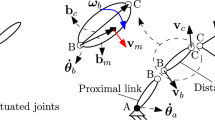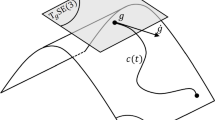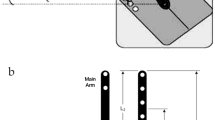Abstract
Multi-loop spatial mechanisms, or parallel mechanisms, are being used to an increasing degree in robotic applications, because they offer some advantages over the open-chain mechanisms. In fact they exhibit high stiffness and low inertia, a fair compliance to the design requirements, and the ability to hold the power actuators in the base. On the other hand, they are often so complex that they can be analyzed only by digital computers, and in general they are designed on the basis of practical solutions rather than theoretical investigations of their structure and kinematics.
This paper on the kinematic analysis of multi-loop spatial mechanisms deals in particular with manipulators with five loops and lower pairs. Two approaches are outlined, according to the different backgrounds of the authors: the decomposition method [9], and a differential approach to the non-linear equation set, 19.(6) which encompasses the direct and inverse kinematic problems, as well as the synthesis of the robot.
The results are then specialized for mechanisms with the end-effector supported by three spatial parallelograms, like the DELTA-4 robot. For this class of mechanisms an interesting property is also demonstrated, which dramatically reduces the need for computation in the kinematic problems.
Sommario
I meccanismi spaziali in catena chiusa, o meccanismi paralleli, trovano sempre più largo impiego in robotica, dal momento che presentano taluni vantaggi rispetto ai meccanismi in catena aperta: offrono tra l'altro elevata rigidezza e bassa inerzia, flessibilità nel soddisfare le esigenze progettuali e possibilità di collocare gli azionamenti nella base. Spesso tuttavia la loro complessità è tale che si possono analizzare solo col computer, e vengono quindi progettati a partire da soluzioni pratiche, piuttosto che da sistematiche basi teoriche. Questo lavoro illustra metodi generali per lo studio cinematico di meccanismi spaziali in catena chiusa, riferendoli al caso di meccanismi con cinque catene e coppie cinematiche elementari. Gli approcci presentati, che riflettono la diversa formazione degli autori, sono: un metodo di decomposizione [9], e un metodo basato sul calcolo differenziale per lo studio del sistema di equazioni non lineari (6) che, in forma implicita, configura i problemi cinematici diretto e inverso e la sintesi del robot.
I risultati vengono quindi applicati a un meccanismo il cui elemento terminale è sostenuto da tre parallelogrammi articolati spaziali, come nel caso del robot DELTA-4. Per questa classe di meccanismi si dimostra anche un'interessante proprietà che riduce drasticamente la quantità di calcoli richiesti dal problema cinematico.
Similar content being viewed by others
References
HuntK. H., Kinematic Geometry of Mechanisms, Clarendon Press, Oxford, 1978, p. 426.
EarlC. F. and RooneyJ., ‘Some kinematic structures for robot manipulator design’, Trans. ASME, J. of Mechanisms, Transmissions, and Automation in Design, 105 (1983) 15–22.
HuntK. H., ‘Structural kinematics of in-parallel-actuated robot-arms’, Trans. J. of Mechanisms, Transmissions, and Automation in Design, 105 (1983) 705–712.
MohamedM. G. and DuffyJ., ‘A direct determination of the instantaneous kinematics of fully parallel robot manipulator:’, Trans. ASME, J. of Mechanisms, Transmissions, and Automation in Design, 107 (1985) 226–229.
Inoue, H., Tsusaka, Y. and Fukuizumi, T., ‘Parallel manipulator’, 3rd ISRR Gouvieux (France), 1985.
FichterE. F., ‘A Stewart platform-based manipulator: general theory and practical construction’, Int. J. Robotics Research, 5(2) (1986) 157–181.
Merlet, J. P., ‘Parallel manipulators, part 1: Theory, design, kinematics and control’, INRIA Report no. 646, Le Chesnay (France), 1987.
Merlet, J. P., ‘Parallel manipulators, part 2: Singular configurations and Grassmann geometry’, INRIA Report No. 791, Le Chesnay (France), 1988.
Alizade, R. I., Hajiyev, E. T. and Tagiyev, N. R., ‘Kinematic analysis of spatial multi-loop sixth-class Mechanisms with six degrees of freedom’ (in Russian), in the collection Optimal Design of Spatial Mechanisms, Baku (USSR) 1984, pp. 12–20.
Clavel, R., ‘DELTA, a fast robot with parallel geometry’, Proc. 18th Int. Symposium on Industrial Robot, Lausanne, 1988.
Riva, R., ‘Synthesis of Stephenson's six-bar linkages by an interactive technique’, Meccanica, Sept. 1981.
Alizade, R. I. and Hajiyev, E. T., ‘Analysis of the spatial one-degree-of-freedom seven-link mechanism with revolute pairs’ (in Russian), in the collection Calculation and Design of Mechanical Systems, Baku (USSR) 1981, pp. 3–19.
AlizadeR. I., DuffyJ. and HajiyevE. T., ‘Mathematical models for analysis and synthesis of spatial mechanisms’, Mechanism and Machine Theory, 18 (1983) 301–328.
Author information
Authors and Affiliations
Rights and permissions
About this article
Cite this article
Garziera, R., Hajiyev, E.T. & Riva, R. Kinematic analysis of multi-loop spatial mechanisms: The five-loop case. Meccanica 26, 101–110 (1991). https://doi.org/10.1007/BF00429875
Received:
Accepted:
Issue Date:
DOI: https://doi.org/10.1007/BF00429875




